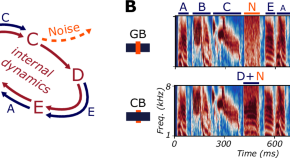The zebra finch auditory cortex reconstructs occluded syllables in conspecific song

Abstract
In the perceptual illusion known as phonemic (or auditory) restoration, when part of a word is deleted and replaced by noise, listeners still hear the complete word. The neural mechanisms that create this illusion by generating predictions of missing information remain poorly understood. Zebra finches (Taeniopygia castanotis) use song, a sequence of complex vocal elements, to communicate in noisy social environments. Here, we found that in anesthetized finches, populations of single units in the homolog of auditory cortex respond to songs in which the original audio of an element is completely replaced by noise as if the missing element were present alongside the noise, despite only noise being physically present. This occurs even for songs birds have never heard, but not if the context is masked or lacks species-typical syntax. These results suggest that local neural dynamics instantiate a general model of conspecific song that biases auditory responses to restore missing information.